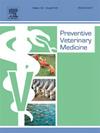The global prevalence of microsporidia infection in rabbits as a neglected public health concern: A systematic review and meta-analysis
IF 2.2
2区 农林科学
Q1 VETERINARY SCIENCES
引用次数: 0
Abstract
Microsporidia are intracellular parasites with significant impact on both animal and human health. The prevalence of microsporidia infections in rabbits, including the genera Enterocytozoon and Encephalitozoon, underscores the importance of understanding their epidemiology for effective control strategies. This systematic review and meta-analysis estimated the global prevalence of microsporidia infection in rabbits using five databases (Scopus, PubMed, Embase, Web of Science, and Google Scholar) to retrieve articles published between 03 December 2003 and 26 March 2023. The global prevalence was estimated with a 95 % confidence interval. All statistical analyses conducted were based on meta-package of R (version 3.6.1). A p-value lower than 0.05 was interpreted as statistically significant. A total of 71 studies comprising 72 datasets were included, yielding a global pooled prevalence of microsporidia infections in rabbits at 0.312 (0.250–0.378). The prevalence varied significantly by continent with highest observed in North America (0.495, 0.151–0.842). Slovenia had the highest pooled prevalence (0.714, 0.654–0.773). Encephalitozoon cuniculi accounted for the highest prevalence (0.338, 0.271–0.407). The findings highlight the global distribution of microsporidia in rabbit populations, emphasizing the zoonotic potential and public health implications. The predominance of E. cuniculi underscores its importance as a widespread pathogen affecting both animal and human health. The data underscore the need for continued surveillance and monitoring, particularly in regions with high prevalence.
兔子小孢子虫感染的全球流行率是一个被忽视的公共卫生问题:系统回顾与荟萃分析。
小孢子虫是对动物和人类健康有重大影响的细胞内寄生虫。兔子小孢子虫感染(包括肠孢子虫属和脑孢子虫属)的流行,凸显了了解其流行病学以制定有效控制策略的重要性。本系统综述和荟萃分析利用五个数据库(Scopus、PubMed、Embase、Web of Science 和 Google Scholar)检索了 2003 年 12 月 3 日至 2023 年 3 月 26 日期间发表的文章,估算了兔子小孢子虫感染的全球流行率。对全球流行率进行了估计,置信区间为 95%。所有统计分析均基于 R 元软件包(3.6.1 版)。P 值低于 0.05 即为具有统计学意义。共纳入了 71 项研究和 72 个数据集,得出兔子小孢子虫感染的全球总流行率为 0.312(0.250-0.378)。各大洲的流行率差异很大,北美洲的流行率最高(0.495,0.151-0.842)。斯洛文尼亚的总体流行率最高(0.714,0.654-0.773)。阴沟脑虫的流行率最高(0.338,0.271-0.407)。研究结果突显了微孢子虫在兔群中的全球分布,强调了人畜共患的可能性和对公共卫生的影响。阴沟肠杆菌占主导地位,凸显了其作为影响动物和人类健康的广泛病原体的重要性。这些数据强调了持续监测和监控的必要性,尤其是在高流行率地区。
本文章由计算机程序翻译,如有差异,请以英文原文为准。
求助全文
约1分钟内获得全文
求助全文
来源期刊

Preventive veterinary medicine
农林科学-兽医学
CiteScore
5.60
自引率
7.70%
发文量
184
审稿时长
3 months
期刊介绍:
Preventive Veterinary Medicine is one of the leading international resources for scientific reports on animal health programs and preventive veterinary medicine. The journal follows the guidelines for standardizing and strengthening the reporting of biomedical research which are available from the CONSORT, MOOSE, PRISMA, REFLECT, STARD, and STROBE statements. The journal focuses on:
Epidemiology of health events relevant to domestic and wild animals;
Economic impacts of epidemic and endemic animal and zoonotic diseases;
Latest methods and approaches in veterinary epidemiology;
Disease and infection control or eradication measures;
The "One Health" concept and the relationships between veterinary medicine, human health, animal-production systems, and the environment;
Development of new techniques in surveillance systems and diagnosis;
Evaluation and control of diseases in animal populations.
 求助内容:
求助内容: 应助结果提醒方式:
应助结果提醒方式:


